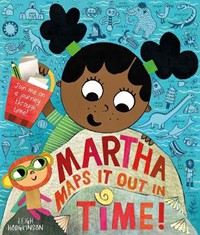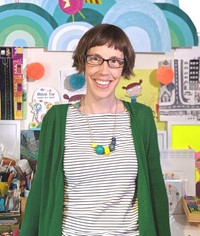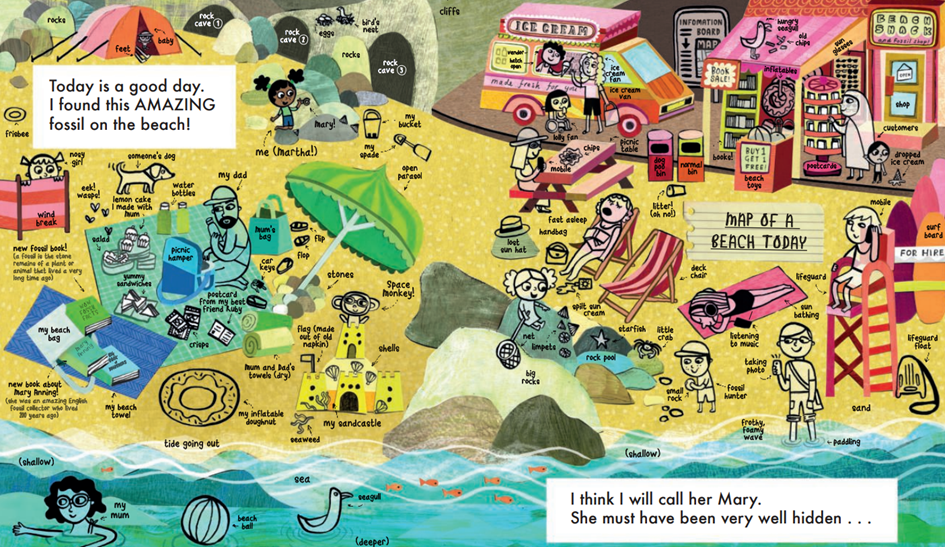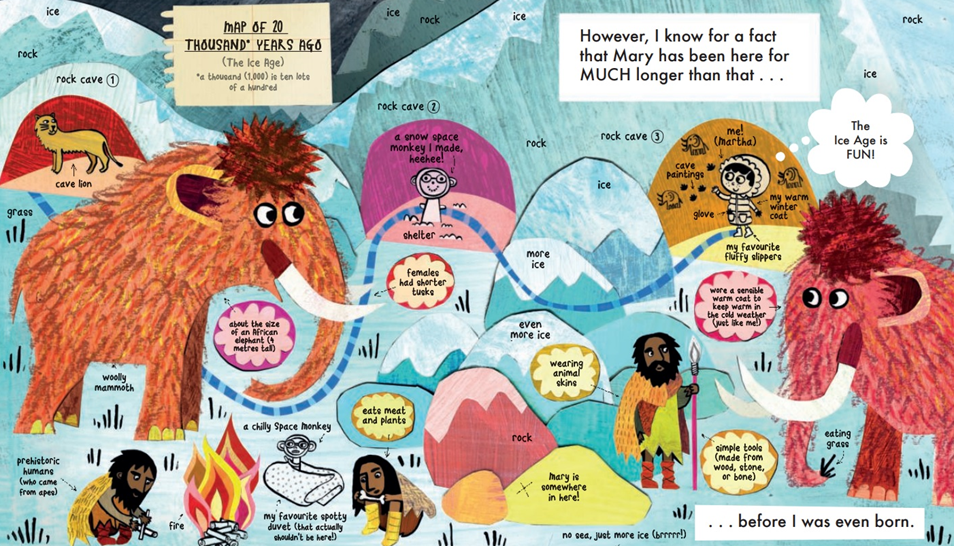Leigh Hodgkinson


About Author
Leigh Hodgkinson joins ReadingZone to introduce her picture books, Martha Maps it Out and Martha Maps it Out in Time.
As well as making picture books, Leigh has worked in animation, including as art director for TV show 'Charlie and Lola' and designer and co-creator of Cbeebies' show 'Olobob Top'.
Leigh has ADHD and says this gives her a 'fizzy brain' and makes her rubbish at relaxing so she is always busy drawing/writing/making/ designing/baking. She gets really grumpy if she can't create. She lives in Lewes, England, with a man, two children, two cats and a very silly sausage dog.
Interview
Martha Maps it Out in Time (OUP Children's)
April 2024
If you are looking for ways to help young children discover the vastness of the world and the universe, and our place in it, then Martha Maps it Out by Leigh Hodgkinson does just this. Her latest picture book, Martha Maps it Out in Time, also starts to unpack the idea of time, from the moment of the Big Bang to the present and possible futures.
Join ReadingZone Live's free virtual author event, Friday 10th May, with Leigh Hodgkinson, introducing children to Martha Maps it Out in Time. Find out more here.
From mapping our neighbourhoods to visiting the stars; from discovering a fossil and understanding how it has reached us from the distant past, these detailed, absorbing picture books help children understand the vastness of our universe and time itself, while also recognising their very special place in our world today.
Review: 'An informative, inspiring, and joyful exploration of the concept of time, and the incredible history of our universe.'
Author and illustrator Leigh Hodgkinson tells us more about Martha and her maps, and her questions
about our world and time itself:
Q&A with Leigh Hodgkinson
" I wanted to help make them see that although they are just a child, they are important, and their ideas are important.
That to have dreams and find things you are passionate about is of great value."
1. Hello Leigh, can you tell us how you trained in illustration, and started creating children's books? What have been your career highlights to date?
I did a degree in graphic design - but actually specialised in animation. I went on to study Animation Direction at the National Film and Television school and worked in the animation industry (as a director/designer/animator/compositor/art director) for about five years before I even started making children's books!
So my career highlights include making my own short films and being art director for Cbeebies' Charlie and Lola animated series; getting my very first book (Colin and the Snoozebox) published!; and being the co-creator, writer and art director of Cbeebies animated series Olobob Top. It's been lovely seeing my books being shortlisted for awards and Martha Maps it Out and Trollswap being used in schools as part of the national curriculum.
2. What is your starting point for a picture book? Have digital technologies changed how you create and illustrate your books?
Usually an interesting snippet of something pops into my head and won't leave me alone. It could be catchy title of a book, a character, a concept, a rhyme, a story, an image. I then have to find that something in the other ingredients, which will turn it into a proper story. All of that usually happens in my head. But when I can't contain it anymore and it is annoying me as it won't go away - I then type it up. Although I am a visual person, I almost always write the complete story before drawing anything.
Digital technologies haven't changed the way I make books as right from the start I mixed real artwork with digital. I like the energy and imperfections of real artwork and also like the specific nonlinear process of working digitally.
Everybody's writing is different, even if using exactly the same pencil, and that is true of digital technologies too - many illustrators use the same few programmes, yet their work looks completely different. So I don't think it matters what you use to create as the expression and aesthetic that comes out is really a visual representation of how your brain works and how you curate your ideas.
"The concept of space/perspective/scale is a tricky one for small children to get their heads around, so I wanted to
make a book that encompassed all the big things and the small things, too, to show that they are all important."
3. Can you tell us what your picture books, Martha Maps it Out and Martha Maps it Out in Time, are about?
Martha Maps it Out is a book about how we fit into the world. It is full of curiosity about scale and extremes… the vastness of the universe and the tiny details that are important to us that perhaps nobody else really even knows about. The concept of space/perspective/scale is a tricky one for small children to get their heads around, so I wanted to make a book that encompassed all the big things and the small things, too, to show that they are all important.
Part of that includes ourselves and how we see ourselves in the world. The hugeness of stuff can be pretty overwhelming - so I wanted the book to give strength and empower the children who read. I wanted to help make them see that although they are just a child, they are important, and their ideas are important. That to have dreams and find things you are passionate about is of great value. To have dreams is to have hope.
Martha Maps it out In Time, like the first book, deals with vastness and extremes. But instead of space, we focus on the concept of time. Time is also a very hard concept for small children to make sense of. My hope is that this book may help, by making it fun, relevant and relatable.
By playfully connecting the dots between stuff that happened millions of years ago, or something that is happening where you are right now, to thinking about how things might look in the future. And that the future can be five minutes from now - or 1000 years from now.
Like the first book, this book too explores how we feel about our world and us being a part of it. In this book, though, I think the emphasis is more on gratitude and being present. To appreciate where we are right now. To stop and notice the little sparkles of magic that we see in our everyday lives when we are sharing things with people we love.

4. How do you approach these ideas in your picture books, and what inspired you to 'map out' Martha's world, and then the world and its considerable history?
I have always loved looking at maps. As a child I loved the maps in book endpapers (in Winnie the Pooh, Milly Molly Many, The Hobbit). I think maps get a bad wrap as being functional and a bit boring- but actually I think they are amazing. I see maps as visual non linear stories that are brimming with possibility. They provide the viewer with a space to be able to create adventures/scenarios/characters without the pressure of being asked to create anything. Maps instil a curiosity in us and make us ask questions… who lives there? Where does that road go? How did they get from there to there?
I really wanted to do a book full of maps as I know that when I was a child I loved to pour over the tiny details of an illustration - to notice things that perhaps other people didn't think were important. It was a way of giving me ownership and making the experience of reading that book personal to me. And if it was personal to me, it was meaningful to me. And if it was meaningful to me, I would think about it and come back to it more.
So in the Martha books, Martha asks questions and thinks about the big stuff that she doesn't fully understand - and that is ok. But by using the visual nature of maps, she is able to break things down so that she can make sense of it. It is a useful and instant way of simplifying and categorising things. It is also a fun way of adding lots of little bits and bobs that people can spot without it interfering with the flow of the narrative, hopefully encouraging the reader to take their time and to realise that the book doesn't have to be rushed.
5. How does Martha Maps it Out in Time link to the first book, Martha Maps it Out, and why did you want to revisit Martha's maps?
The books link as they both feature Martha, her parents and Space Monkey. Martha's curiosity and interests with nature, science and our world is reflected in both books. In the second book, we learn more about Martha's world as we see what it used to be like when she was little, before she was born. These insights help give context and I hope give richness and depth to both the characters and the story.
I wanted to revisit Martha as I think she is a wonderful sponge that just wants to absorb interesting things around her. Also, using the device of a map as a way of visualising thoughts and feelings is useful. It encourages an attitude of sharing who we are in an open and fun way and helps us explore and learn things about ourselves, too.
I really love that maps can be so many things and have so much potential to communicate in a really unique way. So after the first book I knew that there was more we could do, not only with Martha - but also with her maps!
"Mind maps are a great tool to help pin things down. They can help us understand how
certain thoughts, emotions, actions are linked."
6. The 'mind maps' in the stories are really useful; what would you like to encourage young readers to think about after reading these books?
Like I said in the last bit - I think by visualising and putting into words our thoughts/ideas/feelings is a really empowering way to express ourselves in a non-direct way. I feel like mind maps are a safe space where it is all about the process, about the journey and how things are linked. They are working documents where there is no right or wrong way to do it.
I think it is important to show this to young readers, since as a child I would get worried about doing something wrong or making a mistake. But a mind map gives autonomy to the map maker. You don't even have to show anyone - it could be just for you… to help you remember something, or to help you work out something that has been swimming around your head that you can't quite work out.
Our brains are so unique and amazing, but sometimes they are very confusing, overwhelming and scary. So mind maps are a great tool to help pin things down. They can help us understand how certain thoughts, emotions, actions are linked. And this understanding and knowledge is helpful for us to navigate our relationships and our lives.
7. How have children responded to these books - and particularly the idea that we are so small in the universe?
It has been really wonderful seeing children's response to the books. They love to marvel at the hugeness of our universe, and they are really interested in the 'zooming in' structure of the books. I think this is because it helps them connect everything - which is great as this was my hope.
Nobody has really commented on the idea that we are so small in the universe - which I am quite happy about. I am hoping it is because they don't actually feel small by the end of the book- and realise that scale is not the most important thing.
One really special part of Martha Maps it Out for me is when we go from maps of physical things - to a map of Martha's mind… and then we turn the page that leads us back to the universe. I was playing with the idea that the internal landscapes of our minds are as infinite and as incredible as our universe. So actually, even though all of us (children and adults alike) are tiny in comparison to our world / solar system / universe, our imagination, our thoughts, our dreams are limitless!

8. How did you decide on your style of illustrations for these stories? What were the biggest challenges in illustrating Martha Maps it Out in Time?
I didn't really decide on my style of illustrations for these books - this is just the authentic way I draw / see things / put things together. I think for me it is a visual balance between chaos and order, fun and information, story and nuance. Obviously the pages are quite busy and there is a lot going on. So compositionally you have to give the appearance of it looking effortless and natural - but in reality everything you see on the page has been carefully created, considered and placed for a specific purpose.
With Martha Maps in out in Time, I realised that perhaps this was the first book I had made which had to be fact checked by somebody else. I felt such a huge responsibility to get it right and couldn't just rely on my imagination (which is what I usually do!)
I feel like I learnt so much when making this book and I did have a chuckle when I looked at my really specific google history (from googling 'why was there no colour or sound in the big bang?' to 'was there fire in the Hadeon Eon?'!) This has been the only book I have made that my brain actually hurt from trying to understand it all! I went down so many rabbit holes and discovered so many new things!
9. Do you plan to revisit Martha and her maps for future picture books? What else are you creating?
At the moment I am just finishing the roughs for my first graphic novel. It is for 8-12 year olds and is a semi-autobiographical version of my difficult time at secondary school when I was a kid. It will be published next autumn by David Fickling Books (who make the incredible Pheonix comic and publish loads of great books!).
In terms of Martha, we are hoping to do a third book so watch this space! I have written the new text already and will hopefully start making it after I finish my graphic novel after the summer. I love our new Martha idea and so do my publishers at Oxford University Press. I feel very lucky as my team there is so supportive and collaborating with them to create the Martha books has been such a rewarding pleasure in so many ways.
10. What are your favourite ways to relax when you're away from your desk?
Ha - I don't relax! Actually - relaxing makes me very anxious and jittery and I don't like it. I have ADHD and have learnt that doing nothing makes my brain even louder and fizzier. I can't think of anything worse than to try and meditate or have an expensive massage.
So actually to relax, I do things that keep my hands busy. I draw, I knit. I needle punch, crochet, I sew, I paper mache, I make big outdoor sculptures out of concrete, I mosaic, I play the piano, I do pottery,I dance.
I can't just sit and watch tv or a film - I am always doing something at the same time. The bottom line is that I LOVE making things and being immersed in creativity. I genuinely panic that I won't have enough time in my life to try all the crafts I want to try and I won't be able to make all of the things I have ideas for. That fills me with fear...
 Martha Maps It Out In Time
Martha Maps It Out In Time
 Martha Maps It Out
Martha Maps It Out
